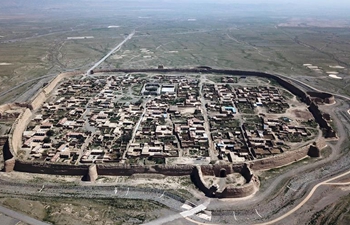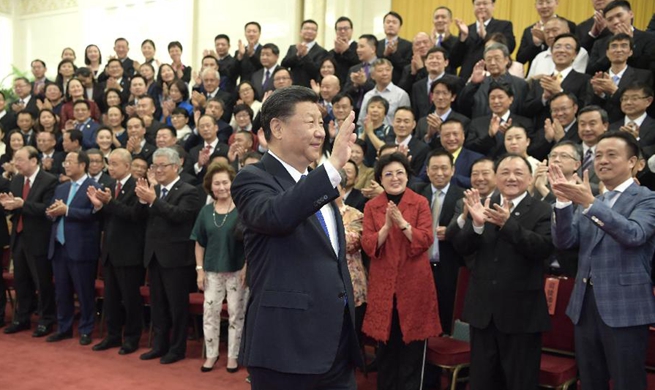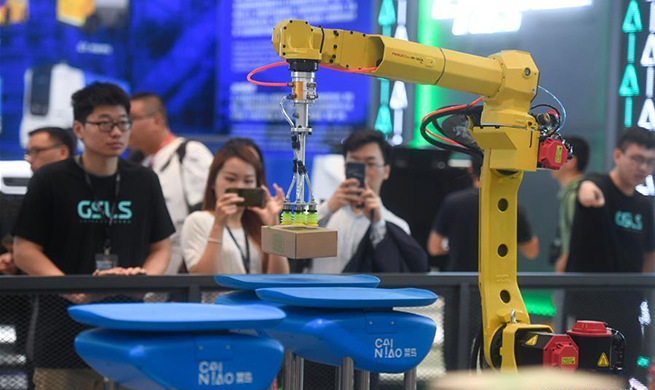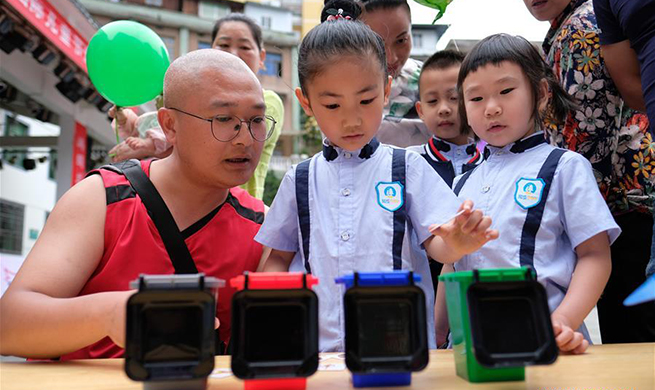by Wang Di, Bui Long
HANOI, May 29 (Xinhua) -- In a baking hot summer morning at the depot of Vietnam's first urban railway in its capital Hanoi, young Vietnamese drivers took turns to get on and off a green-silver electric train, just to check if it has been docked safely with the other train on the same track.
The youths, whose shirts were darkened by drops of sweat, were driver trainees of the Cat Linh-Ha Dong urban railway constructed by the China Railway Sixth Group. These days they were actively partaking in an operational drill with other staff of the urban railway to ensure its smooth and safe commercial operation in the near future.
The operational drill, jointly held by the China Railway Sixth Group and Shenzhen Metro, started in early May and will last to early June with a total of 21 rehearsals, including those of large passenger flow management, rescue of failed trains and emergency response at stations with the participation of some 160 Vietnamese trainees.
"It is very hot, but we are willing to sweat for passengers' safety and comfort," Kieu Tien Dung, one of the Vietnamese driver trainees, told Xinhua after the rehearsal, adding that he felt proud of being a driver of the country's first urban railway.
In the operational drill, a train is assumed to suddenly conk out lying idle on the track, so the drivers need to use another train to approach the "faulty" one and precisely dock them to tow it away for maintenance as quickly as possible.
Dung, a 27-year-old graduate from Vietnam's University of Transport and Communications, said he had studied electric train-relating theory and practice in Beijing with other Vietnamese trainees, and now they are reviewing their lessons in these rehearsals.
"In Beijing, we began with driving simulators, then moved to real trains in real life. After passing exams and getting our certificates, we are back home for more training and practice, ready to become drivers for the first urban railway in Vietnam," he said with a smile.
Dung said he wants to master more advanced train-related technologies and techniques, so that he can drive for the urban railways in Vietnam with the maximum level of safety, and also convey what he has acquired in Beijing to younger drivers.
"Now, I want the Cat Linh-Ha Dong railway to become operational soon to help reduce traffic congestion in Hanoi," Dung said, casting his eyes to the brand-new trains in the depot.
Not far from the depot in the railway's Operating Control Center in the city's Ha Dong district, Dung's colleague Dinh Thien Vuong was tentatively driving a simulator which looks same as the real train locomotive in the depot, with a big screen in front of the driver showing moving images of vivid and lifelike scenery of Hanoi along the track.
The simulator can not only be used to practice driving skills, but also provide Vuong and his colleagues with all kinds of scenarios they might encounter in future work, from a waterlogged track after heavy rains to a simulated fire alarm on the platform. When an "obstacle" appears on the screen, Vuong would try to solve it as he was taught in Beijing. A Chinese instructor stayed with him and was ready to answer his questions via an interpreter.
"Recently, we have been further practicing driving skills on this simulator as well as on real trains," Vuong said. The man, a father of two, told Xinhua that the Chinese side has made very good preparation in terms of training programs.
"Urban railway is a new sector in Vietnam. It will develop in the future. We drivers have made efforts to master the technologies and now we can drive this electricity-powered trains fairly well."
While drivers have to stage rehearsals of different scenarios on the track and in the train to ensure that they can rapidly and effectively handle them in case of emergency, staff on each station of the urban railway are also taking part in all kinds of rehearsals for possible scenarios, for example, how to deal with a sudden passenger surge during rush hours.
At Van Quan Station, Vu Thi Cuc, traffic controller trainee of the Cat Linh-Ha Dong urban railway, was quickly adapting her role as the exchange center of a huge amount of information and orders. Holding a telephone receiver in her left hand, and agilely moving a computer mouse with right hand, she was as busy as a bee, gluing her eyes on a monitoring screen full of real-time images fed by more than 20 surveillance cameras in the station.
Cuc and dozens of other staff trainees were partaking in a rehearsal about large passenger flow management. If too many passengers flock to the station, Cuc and her colleagues must calmly conduct standard procedures according to the levels of congestion, like guiding passengers for a quick exit, calling the control center to send more trains or changing the settings of elevators and turnstiles to avoid congestion.
All need to be practiced repeatedly to ensure tacit cooperation between different posts.
"The training of Vietnamese trainees for the urban railway began in 2014, spanning China and Vietnam and going through four stages with this drill as a test of training results," Meng Qiuxuan, deputy director of the Materials and Equipment Department of the Overseas Branch of the China Railway Sixth Group, told Xinhua.
The 13-km Cat Linh-Ha Dong elevated railway, which runs through 12 stations in three districts, overlaps with some of the busiest route in Hanoi. It was widely expected to ease the growing rush hour traffic jam in the capital city with a population of more than 9.6 million people, most of whom drive motorbikes for daily commuting.
"I'm eager to experience this urban railway myself, not only as a staff but also as a passenger," Cuc said effervescently. "It is the first of its kind in Hanoi as well as in Vietnam. Besides solving traffic congestion, public transportation like this urban railway helps reduce pollution and is good for the environment."













